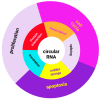Circular RNA-Is the Circle Perfect?
- PMID: 34944400
- PMCID: PMC8698871
- DOI: 10.3390/biom11121755
Circular RNA-Is the Circle Perfect?
Abstract
Circular RNA (circRNA) is a distinct class of non-coding RNA produced, in principle, using a back-splicing mechanism, conserved during evolution, with increased stability and a tissue-dependent expression. Circular RNA represents a functional molecule with roles in the regulation of transcription and splicing, microRNA sponge, and the modulation of protein-protein interaction. CircRNAs are involved in essential processes of life such as apoptosis, cell cycle, and proliferation. Due to the regulatory role (upregulation/downregulation) in pathogenic mechanisms of some diseases (including cancer), its potential roles as a biomarker or therapeutic target in these diseases were studied. This review focuses on the importance of circular RNA in cancer.
Keywords: biomarker; cancer; circular RNA.
Conflict of interest statement
The authors declare no conflict of interest.
Figures


Similar articles
-
Translation and functional roles of circular RNAs in human cancer.Mol Cancer. 2020 Feb 15;19(1):30. doi: 10.1186/s12943-020-1135-7. Mol Cancer. 2020. PMID: 32059672 Free PMC article. Review.
-
Dysregulated Expression Patterns of Circular RNAs in Cancer: Uncovering Molecular Mechanisms and Biomarker Potential.Biomolecules. 2024 Mar 22;14(4):384. doi: 10.3390/biom14040384. Biomolecules. 2024. PMID: 38672402 Free PMC article. Review.
-
The Use of circRNAs as Biomarkers of Cancer.Methods Mol Biol. 2021;2348:307-341. doi: 10.1007/978-1-0716-1581-2_21. Methods Mol Biol. 2021. PMID: 34160816 Review.
-
CircRNAs and their regulatory roles in cancers.Mol Med. 2021 Aug 26;27(1):94. doi: 10.1186/s10020-021-00359-3. Mol Med. 2021. PMID: 34445958 Free PMC article. Review.
-
Intriguing circles: Conflicts and controversies in circular RNA research.Wiley Interdiscip Rev RNA. 2019 Sep;10(5):e1538. doi: 10.1002/wrna.1538. Epub 2019 Apr 29. Wiley Interdiscip Rev RNA. 2019. PMID: 31034768 Review.
Cited by
-
Circular RNAs: Biogenesis, Biological Functions, and Roles in Myocardial Infarction.Int J Mol Sci. 2023 Feb 20;24(4):4233. doi: 10.3390/ijms24044233. Int J Mol Sci. 2023. PMID: 36835653 Free PMC article. Review.
-
The role of ncRNA regulatory mechanisms in diseases-case on gestational diabetes.Brief Bioinform. 2023 Nov 22;25(1):bbad489. doi: 10.1093/bib/bbad489. Brief Bioinform. 2023. PMID: 38189542 Free PMC article. Review.
-
The role of ncRNAs in depression.Heliyon. 2024 Mar 6;10(6):e27307. doi: 10.1016/j.heliyon.2024.e27307. eCollection 2024 Mar 30. Heliyon. 2024. PMID: 38496863 Free PMC article. Review.
-
MiRNAs and circRNAs for the Diagnosis of Anthracycline-Induced Cardiotoxicity in Breast Cancer Patients: A Narrative Review.J Pers Med. 2022 Jun 28;12(7):1059. doi: 10.3390/jpm12071059. J Pers Med. 2022. PMID: 35887556 Free PMC article. Review.
-
Exploring the evolving roles and clinical significance of circRNAs in head and neck squamous cell carcinoma.J Cancer. 2024 May 30;15(12):3984-3994. doi: 10.7150/jca.96614. eCollection 2024. J Cancer. 2024. PMID: 38911371 Free PMC article. Review.
References
Publication types
MeSH terms
Substances
LinkOut - more resources
Full Text Sources
Medical

